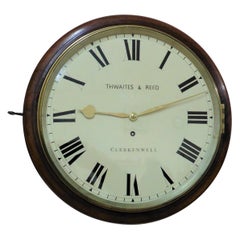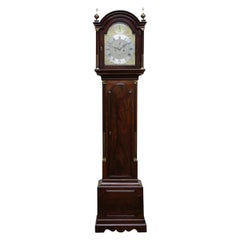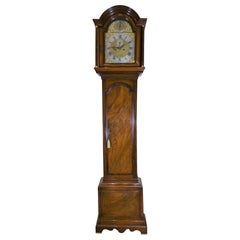Want more images or videos?
Request additional images or videos from the seller
1 of 9
Congreve Rolling Ball Clock by Thwaites & Reed, London
$17,164.02List Price
About the Item
- Creator:Thwaites & Reed (Clockmaker)
- Dimensions:Height: 21.5 in (54.61 cm)Width: 18.5 in (46.99 cm)Depth: 12.5 in (31.75 cm)
- Materials and Techniques:
- Place of Origin:
- Period:
- Date of Manufacture:1973
- Condition:Wear consistent with age and use. very good condition.
- Seller Location:Norwich, GB
- Reference Number:Seller: SKU000011881stDibs: LU4037334473862
About the Seller
5.0
Vetted Professional Seller
Every seller passes strict standards for authenticity and reliability
1stDibs seller since 2018
65 sales on 1stDibs
Typical response time: 5 hours
Associations
The British Antique Dealers' AssociationLAPADA - The Association of Arts & Antiques Dealers
Authenticity Guarantee
In the unlikely event there’s an issue with an item’s authenticity, contact us within 1 year for a full refund. DetailsMoney-Back Guarantee
If your item is not as described, is damaged in transit, or does not arrive, contact us within 7 days for a full refund. Details24-Hour Cancellation
You have a 24-hour grace period in which to reconsider your purchase, with no questions asked.Vetted Professional Sellers
Our world-class sellers must adhere to strict standards for service and quality, maintaining the integrity of our listings.Price-Match Guarantee
If you find that a seller listed the same item for a lower price elsewhere, we’ll match it.Trusted Global Delivery
Our best-in-class carrier network provides specialized shipping options worldwide, including custom delivery.You May Also Like
Miniature English William Congreve Rolling Ball Clock
Located in Danville, CA
Here is a beautiful miniature Congreve rolling ball clock. This one comes with a solid marble display base and protective dome. The glass dome has solid brass frames. The clock is made of heavy solid brass. The time shows on 3 separated porcelain dials - second, minute, and hour. The clock is driven by a double spring movement. It is really fun to watch this clock running. It has an 8 DAY movement. The bigger version from our competitor wouldn't even run 8 days. Our smallest 8 day Congreve clock...
Category
Late 20th Century Table Clocks and Desk Clocks
Materials
Brass
Thwaites and Reed 19th Century Wall Clock
Located in London, GB
This beautiful wall clock was made by Thwaites and Reed in the late 19th century.
The case is mahogany and numbered 118 with a small ivorine plaque - these clocks were made for establishments such as the Inns of Court and the Bank of England in London. The company were also employed to service them.
The clock is wound with the original key and has a lovely deep tick tock (no chime). The diameter of the clock face is 30cm.
Thwaites and Reed are the epitome of a traditional English antique company...
Category
Antique Late 19th Century British Late Victorian Wall Clocks
Materials
Brass
24K Gold Plated Miniature 8 Day English William Congreve Rolling Ball Clock
Located in Danville, CA
24K Mini English William Congreve Rolling Ball Clock with Front Door & Storage
Here is a beautiful miniature Congreve rolling ball clock. It's one of the smallest you can find. The ...
Category
Late 20th Century Table Clocks and Desk Clocks
Materials
Brass
$2,200
H 16 in W 11 in D 10.5 in
Rare Vintage French Style Mystery 8 Day Waterwheel Rolling Ball Industrial Clock
Located in Danville, CA
For your consideration is a mystery Water Wheel Industrial Ball Bearing Clock. It comes with an 8 day movement and keeps very good time!! This water wheel industrial clock has a big paddle wheel on the right side which hold a a set of small steel ball bearings. The weight of these balls is propelling the clock. Please note the time shows a thin glass dial with Roman numerals. Every 60 seconds, a small ball drops down from the water wheel onto the track where the steel ball rolls to the left side. The bucket catches the ball and move it up one by one. Every 60 seconds, a steel ball drops from the left bucket on the channel to the waterwheel. Then the bucket drops down and go around to catch another ball bearing. The loops goes on as the clock keeps on running. The buckets chain is made of brass and nicely done. The power is received from an 8 day fusee movement inside the solid hardwood base, red ash. And the clock has a pendulum on the back to regulate the timing. The whole animation of this clock is just like a waterwheel except it's ball bearing "flowing" through channels and there is a clock on the big water wheel. The clock is protected by a glass dome. It measure 17-3/4" tall, 17-3/4" wide, and 8-3/4" deep including the glass dome. I'm sure this clock will upscale any clock store...
Category
Late 20th Century Table Clocks and Desk Clocks
Materials
Brass, Stainless Steel
$18,500
H 17.75 in W 17.75 in D 8.75 in
Eureka Clock Company, London. Dial Clock
Located in Amersham, GB
A superb example of a Eureka wall clock made c1911.
The electromagnetic movement is regulated by a large, slowly oscillating bi-metallic balance wheel, with the correct battery these clock will run for the duration of the battery life. Housed in a mahogany dial clock case with turned dial frame and brass bezel, the movement is visible through a cut out in the dial so the oscillation can be seen. The movement is numbered 5676 and stamped with the patent no 14614/1906 Made in England. The dial retains its original painted finish (cracked in places).
This is the only model of wall clock Eureka made and is one of the rarer designs as they mostly concentrated on mantel clocks.
The Eureka clock...
Category
Vintage 1910s English Edwardian Wall Clocks
Materials
Brass, Copper, Steel
Single Fusee Mantel clock by Hay London
By HAY
Located in Amersham, GB
An unusual english single fusee mantel clock in a Louis XV style rocaille ormolu case in the french taste. The eight day fusee movement is of superb quality with a pendulum descendin...
Category
Antique Early 19th Century British Rococo Mantel Clocks
Materials
Bronze
Regency Mahogany Tall Case Clock By W. Ashford, London
Located in Essex, MA
With arched bonnet with brass finials over a convex glass bezel opening to a steel clock face. Newly cleaned and put in ready to go condition. The case with pendulum door. Weights, k...
Category
Antique 1810s English Regency Grandfather Clocks and Longcase Clocks
Materials
Brass, Iron
Original HOVIS Prize Clock by G.H.& F.W. Bravington London
Located in Godshill, Isle of Wight
Original HOVIS Prize Clock by G.H.& F.W. Bravington London
Clocks like this one were won by Bakery shops and presented by Hovis, this was a very prestigious award for the recipient
...
Category
Early 20th Century Late Victorian Table Clocks and Desk Clocks
Materials
Oak
Mid 19th Century Bracket Clock By Jump, London
Located in Lincolnshire, GB
A two train 19th century ebonised bracket clock by Jump, London. A fine quality movement, signed on the back plate.
Circa 1860
Height is to the top of the handle
Category
Antique Mid-19th Century English Mantel Clocks
Materials
Brass
Huge English Illuminated advertising clock by Smiths of London
Located in London, GB
Huge English Illuminated advertising clock by Smiths of London
“Time stands still for no one” as the saying goes.
A colossal example of an Illuminated advertising clock by Smiths ...
Category
Vintage 1920s British Late Victorian Grandfather Clocks and Longcase Clocks
Materials
Metal
More From This Seller
View AllRegency Round Dial Wall Clock by Thwaites and Reed, London
Located in Norwich, GB
English round dial wall clock by Thwaites and Reed.
Mahogany round dial wall clock with cast brass bezel opening to a painted twelve inch dial sign...
Category
Antique 19th Century British Regency Wall Clocks
Materials
Mahogany
Small Mahogany Mantel Clock by Webster, London
By Richard Webster
Located in Norwich, GB
Small mahogany mantel clock by Webster, London
Break arch case with applied carved decoration resting on a shaped stepped plinth and standing on four brass ball feet.
Brass bezel opening to the silvered dial with Roman numerals, original ‘blued’ steel hands signed Webster, Queen Victoria Street, London.
The hinged back door opening to the eight day movement with platform escapement striking the hours and halves on a coiled gong. The backplate of the clock also signed Webster. C.1880
The Webster family clockmaking business was founded by William Webster and passed from father to son for almost 200 years.
William Webster was apprenticed to John Barnet in 1701 and then transferred to Thomas Tompion...
Category
Antique 1880s English Late Victorian Mantel Clocks
Materials
Mahogany
George I Longcase Clock by William Holloway, London
Located in Norwich, GB
George I longcase clock by William Holloway, London
Georgian longcase clock in a finely figured mahogany case standing on a stepped ba...
Category
Antique 1720s British Georgian Grandfather Clocks and Longcase Clocks
Materials
Mahogany
Georgian Mahogany Longcase Clock by John Taylor, London
Located in Norwich, GB
Georgian Longcase clock by John Taylor, London
Finely figured flame mahogany case with stepped shaped plinth and inset panel to the bas...
Category
Antique 1780s English Georgian Grandfather Clocks and Longcase Clocks
Materials
Mahogany
Georgian Mahogany Bracket Clock by Hector Simpson, London
Located in Norwich, GB
Georgian mahogany bracket clock by Hector Simpson, London.
Georgian bracket clock in a finely figured flame mahogany case standing on a r...
Category
Antique 1780s British Georgian More Clocks
Materials
Mahogany
Regency Mahogany Bracket Clock by George Grove, London
Located in Norwich, GB
Small regency bracket clock.
Mahogany chamfered top case surmounted by a brass pineapple finial with brass inlay, standing on a raised plint...
Category
Antique 1820s English Regency Mantel Clocks
Materials
Mahogany
Recently Viewed
View AllMore Ways To Browse
Prince Regent
Architectural Pediment
Ball Clock
London Brass Clocks
Vintage Ball Clock
Silver Tray And Mahogany Table
Rolling Clock
Vintage Rolling Ball Clock
Congreve Clock
Congreve Rolling Ball Clock
Congreve Rolling Ball
Thwaites And Reed
Thwaites Clock
Antique Metal Mantel Clocks
Louis Xv Ormolu Clocks
Antique Clock Bell
French Rococo Gilt Bronze Mantel Clock
Cherubs Garlands



